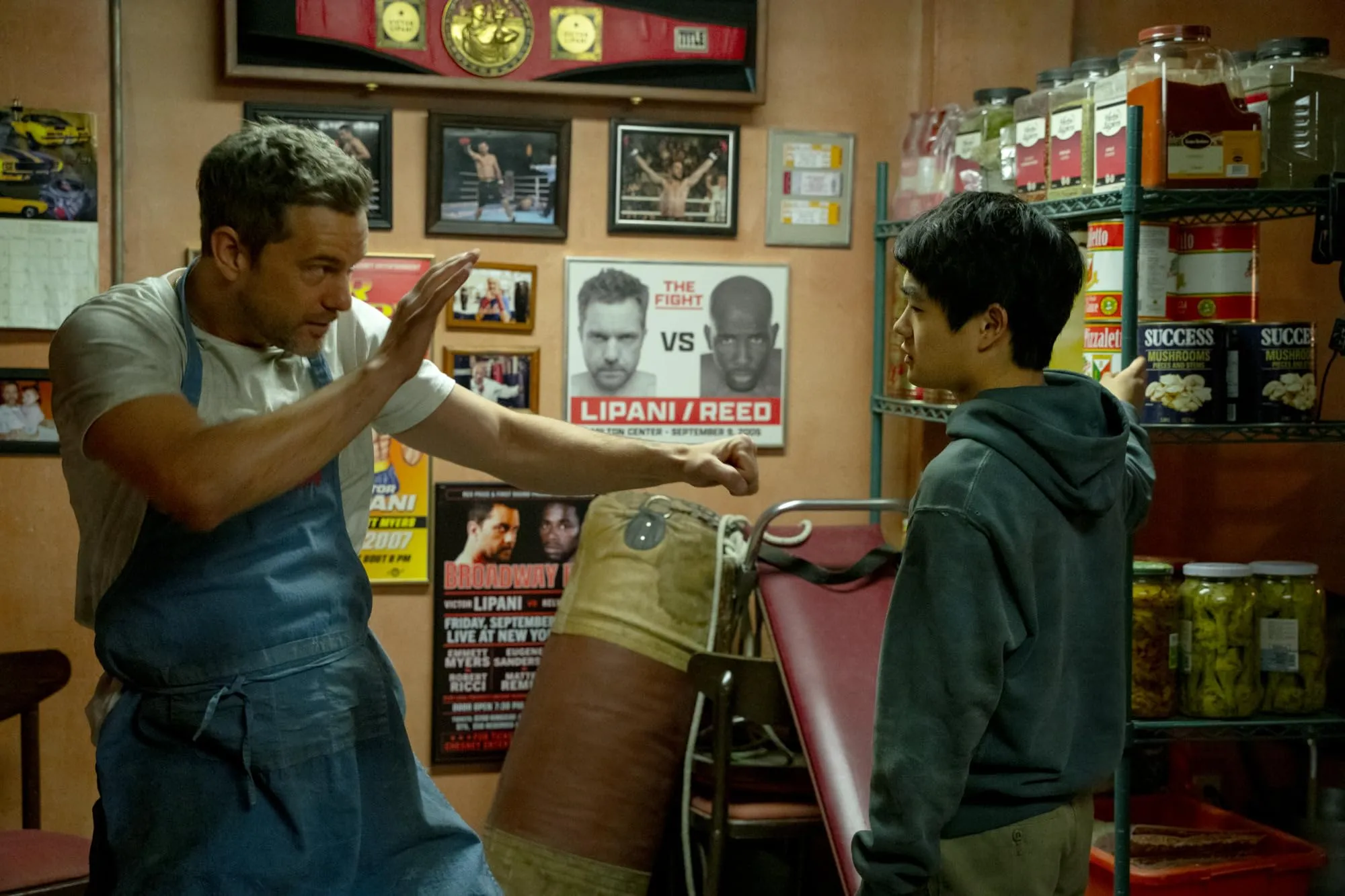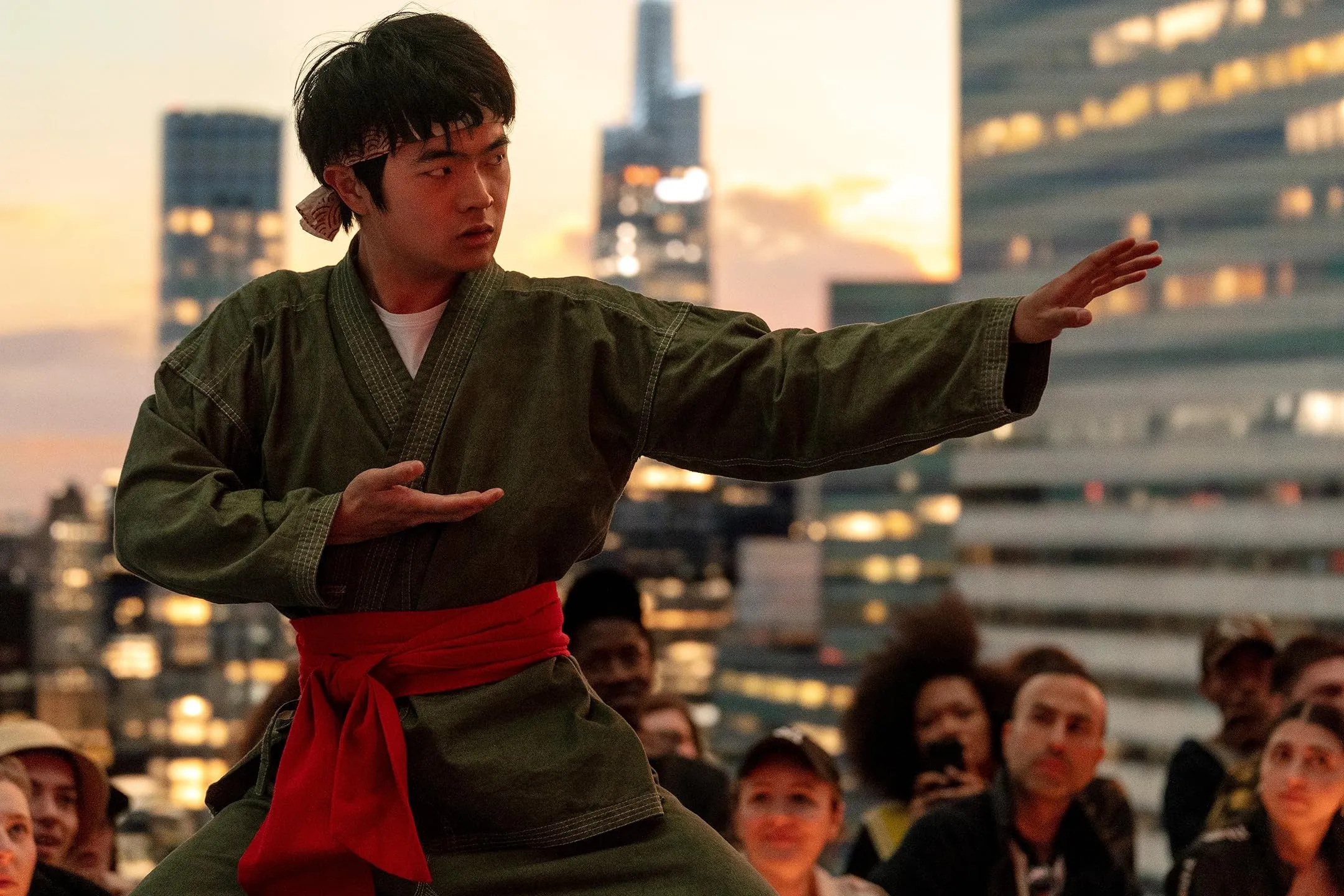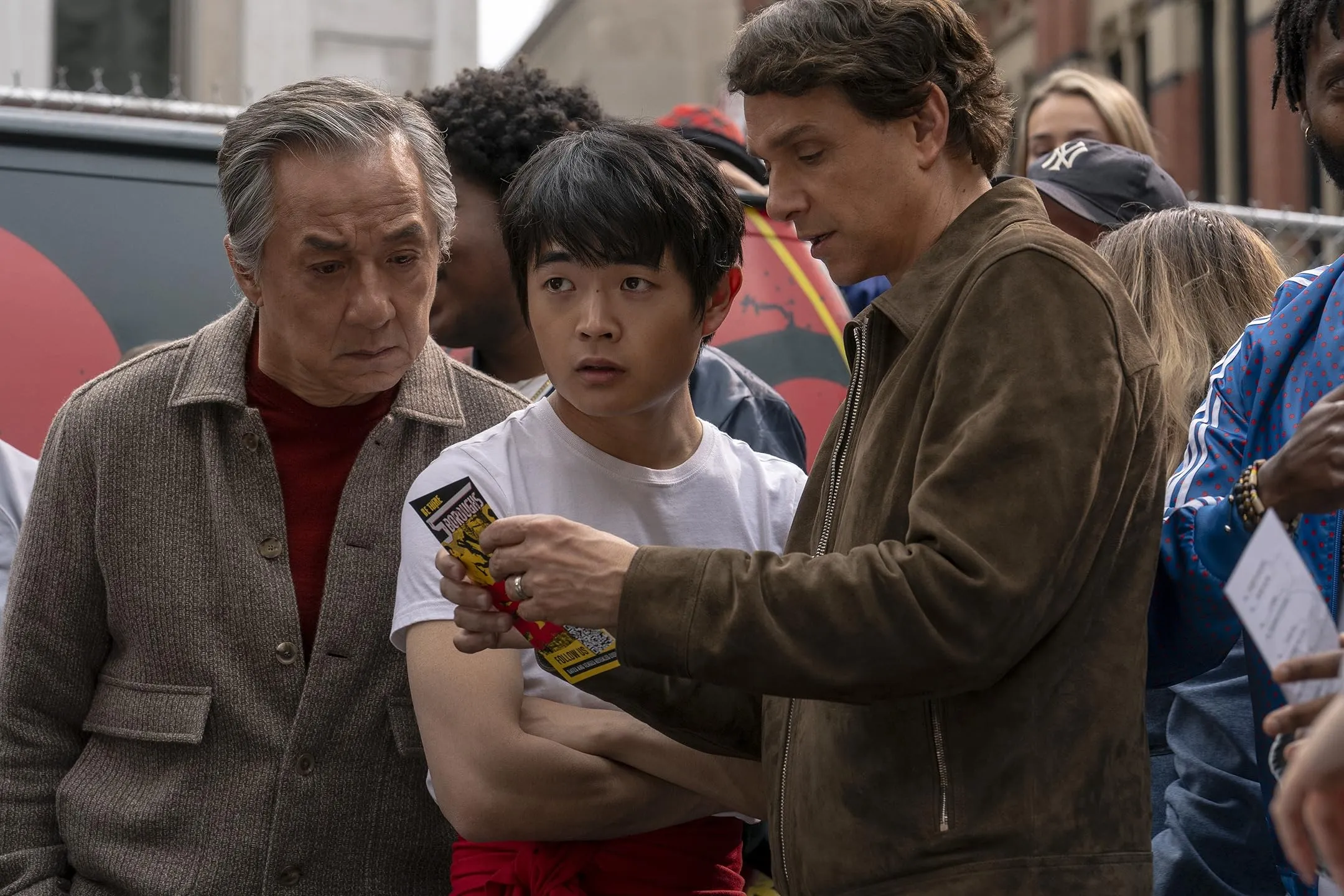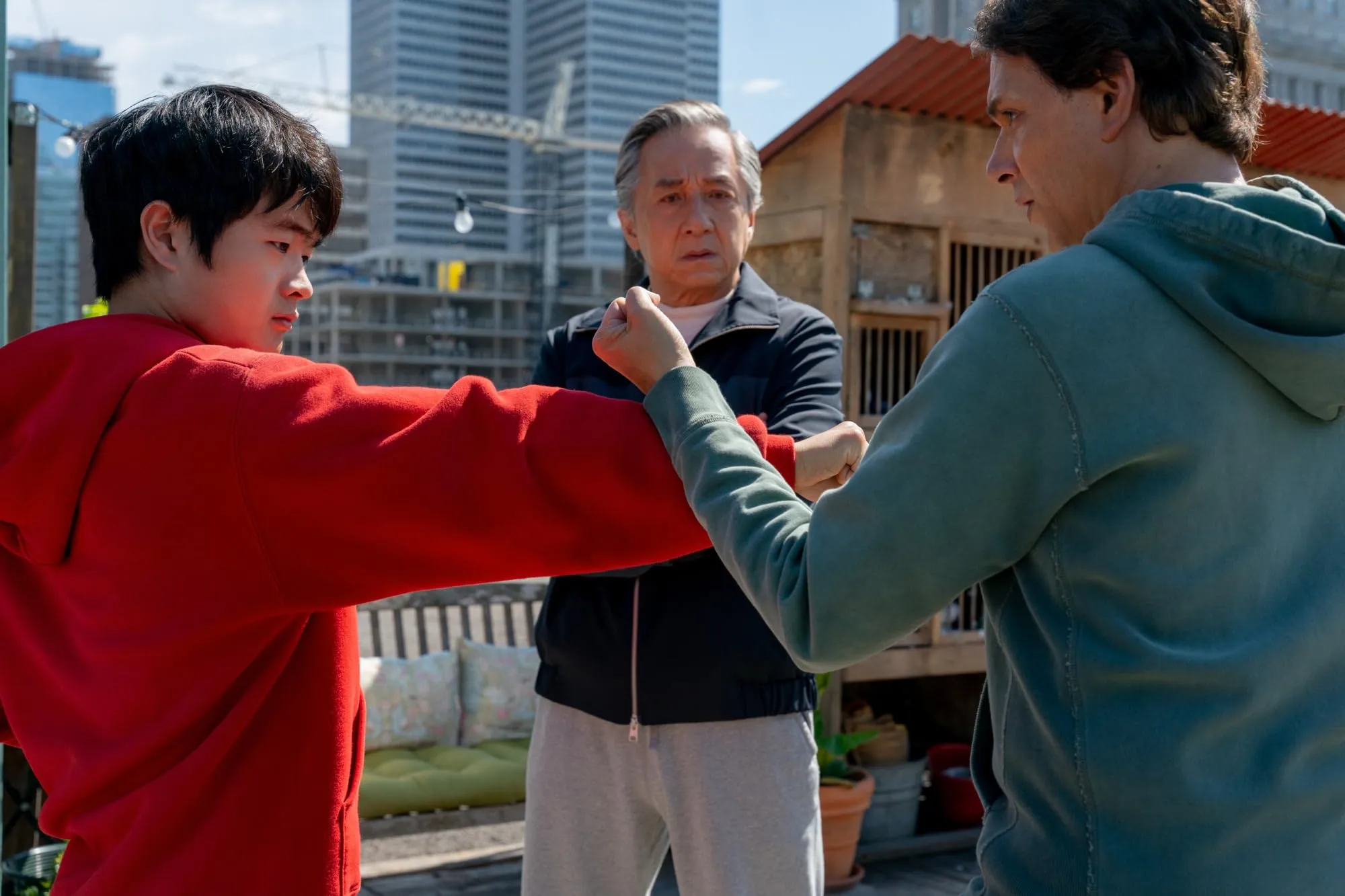The cinematic institution of the Karate Kid saga once more unfurls its narrative scroll, presenting Karate Kid: Legends not merely as continuation but as an attempt to introduce new patterns into an established form. Here enters a young adept, Li Fong, transplanted from Beijing’s disciplined calm to the cacophonous heart of New York City alongside his mother.
He arrives burdened by a tragedy that has silenced his fists and a solemn vow to forsake the very arts that define him. Yet, the familiar silhouettes of Mr. Han and Daniel LaRusso loom, their wisdom poised to intersect with this nascent passage. Thus, the stage is set for a poignant exploration: a boy’s quiet battle to honor a painful past against the relentless currents urging him back toward conflict and, perhaps, self-discovery.
Urban Crucible: New Bonds, Old Echoes
Upon arrival in New York’s sprawling anonymity, Li Fong carries his vow against violence – a solemn pact with his mother, Dr. Fong, forged in the crucible of his brother’s tragic demise – like an invisible shield. This internal edict amplifies the typical anxieties of a newcomer; the city’s relentless energy and the high school’s intricate social hierarchies initially present a formidable, isolating challenge to his spirit, already steeped in grief.
Yet, within this urban maze, human connections inevitably spark. Mia emerges as a figure of genuine warmth and unassuming grace, her interactions with Li fostering a sweet, tentative rapport that promises solace. Their bond, however, soon casts them into the path of Conor, Mia’s former suitor and a local karate exponent whose possessive nature and quick aggression embody the film’s primary youthful antagonism.
His presence serves as an immediate, physical test to Li’s restrained existence. Away from these direct confrontations, other anchors appear. Victor, Mia’s father, a former pugilist now a pizzeria owner, offers an easygoing, paternal counterpoint, his life lessons delivered with an unpretentious charm. A different kind of companionship is found in Alan, Li’s academically-minded tutor, whose quick wit provides necessary moments of light relief.
A Prodigy’s Burden, A Protector’s Path
The narrative soon veers into unexpected territory, as the quietude of Li’s existence is shattered by the encroaching troubles of his newfound father figure, Victor. We learn of Victor’s precarious financial footing, his debts to unscrupulous loan sharks operating under the aegis of O’Shea, Conor’s own martial arts guide—thus tightening the net of antagonism.
It is in defense of Victor, against the brutish enforcers of this debt, that Li’s suppressed kung fu skills are explosively revealed. This act of loyalty precipitates a curious and compelling reversal of roles: the adolescent Li, still grappling with his own trauma, assumes the mantle of mentor, meticulously training the elder Victor for a make-or-break boxing match.
Their shared endeavor, captured in sequences that blend unorthodox methods with genuine commitment, forges a palpable bond, a testament to reciprocal reliance that briefly upends the traditional master-pupil dynamic.
However, this uplifting interlude proves fragile. Victor’s bid for redemption in the ring is cruelly subverted by blatant cheating, leaving him not just defeated but grievously injured. For Li, this outcome is devastating, reopening past wounds associated with his brother’s tragic end and instilling a crushing sense of responsibility for Victor’s plight. From this crucible of guilt and urgency, a new resolve is forged.
Li decides he must enter the high-stakes ‘Five Boroughs’ martial arts tournament, its substantial cash prize offering the only apparent means to alleviate Victor’s debt. This decision is freighted with significance: it represents a conscious defiance of his mother’s explicit wish and forces Li to directly engage the very fighting spirit he had sworn to abandon, setting him on a collision course with his deepest fears.
Two Branches, One Tree: The Confluence of Mentorship
With Li now committed to the tournament, the narrative summons the first of its titular legends: Mr. Han, the boy’s original kung fu sifu, arrives from Beijing, a figure of quiet authority and deep concern for his pupil. Discerning Li’s predicament, Han’s response is not admonishment but a pragmatic resolve to guide him. His initial training regimen for Li is steeped in the exacting disciplines of kung fu, emphasizing precision and internal strength.
However, the specific vernacular of the New York tournament—karate—necessitates a broader expertise. This crucial distinction prompts Han to seek out the franchise’s other cornerstone, Daniel LaRusso. The film attempts to forge a convincing link between these two mentors, invoking the legacy of Mr. Miyagi to posit a shared philosophical heritage, an idea encapsulated by the ‘two branches, one tree’ metaphor.
This connection is underscored, perhaps with a touch of nostalgic license, through what seems to be selectively employed archival footage. The interplay between Chan’s Han and Macchio’s LaRusso develops with an amiable chemistry, their contrasting teaching styles – Han’s solemnity against LaRusso’s seasoned, slightly more laid-back charm – providing moments of gentle humor as they navigate their co-mentorship.
Under their combined tutelage, Li’s training transforms into a rigorous synthesis of methodologies. Echoes of past training sequences resonate, notably in inventive reinterpretations of classic drills like the ‘jacket on, jacket off’ exercise.
The evolution in Li’s fighting ability is palpable as he learns to integrate the diverse strengths of both kung fu and karate, shaping a more versatile combat style. More profoundly, Han and Daniel impart crucial lessons that extend beyond technique, focusing on the mental and ethical foundations essential to a true martial artist.
Kinetic Canvas: Style, Combat, and Echoes of the Past
Visually, Karate Kid: Legends embraces a contemporary dynamism. Director Jonathan Entwistle infuses the proceedings with a restless energy, a tempo frequently amplified by an insistent, uptempo musical score and rapid-fire editing.
This stylistic choice, cultivating youthful immediacy and employing flourishes like comedic audio slow-downs, occasionally prioritizes momentum over moments of quiet emotional depth, potentially short-changing the affective weight of certain interactions.
The fight choreography is delivered with kinetic competence, charting Li’s development and the impressive execution of signature maneuvers like his ‘dragon kick,’ often highlighted with dramatic slow-motion. The ‘Five Boroughs’ tournament escalates in spectacle, from street-level encounters—sometimes adorned with video-game-inspired graphics or comic-book panel aesthetics—to a climactic, picturesquely staged rooftop duel at sunset. Animated interludes offer brisk exposition. These visual augmentations aim for a modern feel, though their integration can sometimes appear more as an overlay.
A profound awareness of its cinematic ancestry permeates the film. It liberally sprinkles callbacks, beginning with an archival quotation from The Karate Kid Part II. The narrative architecture harmonizes disparate franchise elements, notably incorporating Jackie Chan’s 2010 Mr. Han into the central LaRusso-Miyagi timeline. An end-credits appearance by another familiar face further cements its ties to the saga.
The Resonance of Resolve: Archetypes and Awakenings
At its foundation, Karate Kid: Legends draws power from the enduring archetype of the underdog, a narrative structure that consistently fosters audience investment. Li Fong’s journey, marked by initial disadvantage and escalating challenges, fits neatly within this tradition, his struggles designed to elicit empathy and anticipation for his eventual triumph.
His emotional trajectory is central, tracing a path from the paralyzing grief of his brother’s death and a self-imposed exile from martial arts, toward a gradual reclamation of his spirit. Guided by his mentors, his re-engagement with fighting becomes a conduit for healing, a means to confront his trauma and redefine his identity not as a victim of circumstance but as an agent of his own strength. Dr. Fong’s own arc, though less prominent, reflects a mother’s protective instincts evolving towards an understanding of her son’s necessary path.
The burgeoning romance between Li and Mia offers a gentle counterpoint to the film’s more combative elements, providing Li with a crucial source of emotional support and personal growth. The presence of multiple benevolent male figures—Victor’s grounded warmth, Mr. Han’s disciplined wisdom, and Daniel LaRusso’s experienced guidance—collectively shapes Li’s development, each contributing distinct facets to his maturation.
In contrast, the antagonists, Conor and his mentor O’Shea, function primarily as catalysts for conflict, their characterizations serving the plot’s demands for opposition rather than exploring nuanced villainy. The film’s thematic core, the synthesis of kung fu and karate, is eloquently expressed through the “two branches, one tree” philosophy, suggesting a deeper unity underlying distinct traditions, a message of shared heritage and the strength found in integration.
Karate Kid: Legends is scheduled for release in the United States on May 30, 2025.
Full Credits
Director: Jonathan Entwistle
Writer: Rob Lieber
Producers: Karen Rosenfelt, James Lassiter
Cast: Ben Wang, Jackie Chan, Ralph Macchio, Joshua Jackson, Sadie Stanley, Ming-Na Wen, Aramis Knight, Wyatt Oleff, Shaunette Renée Wilson, William Zabka
Director of Photography (Cinematographer): Justin Brown
Editor: Dana E. Glauberman
Composer: Dominic Lewis
The Review
Karate Kid: Legends
Karate Kid: Legends revisits familiar underdog rhythms with a likable new lead and the welcome chemistry of its returning masters. While its energetic pacing and stylistic flourishes sometimes overshadow emotional nuance, and its antagonists remain thinly sketched, the film capably merges martial arts traditions and offers moments of genuine heart, particularly in its unconventional mentorship dynamics. It’s a worthy, if not groundbreaking, addition to the saga.
PROS
- Appealing new protagonist in Li Fong.
- Engaging chemistry between Jackie Chan and Ralph Macchio.
- Effective blend of martial arts traditions.
- Heartfelt mentorship dynamics, including Joshua Jackson's standout role.
- Kinetic fight sequences.
CONS
- Formulaic plot structure.
- Rapid pacing can undercut emotional depth.
- Underdeveloped antagonists.
- Some distracting visual or stylistic choices.
- Occasional reliance on familiar tropes.




















































